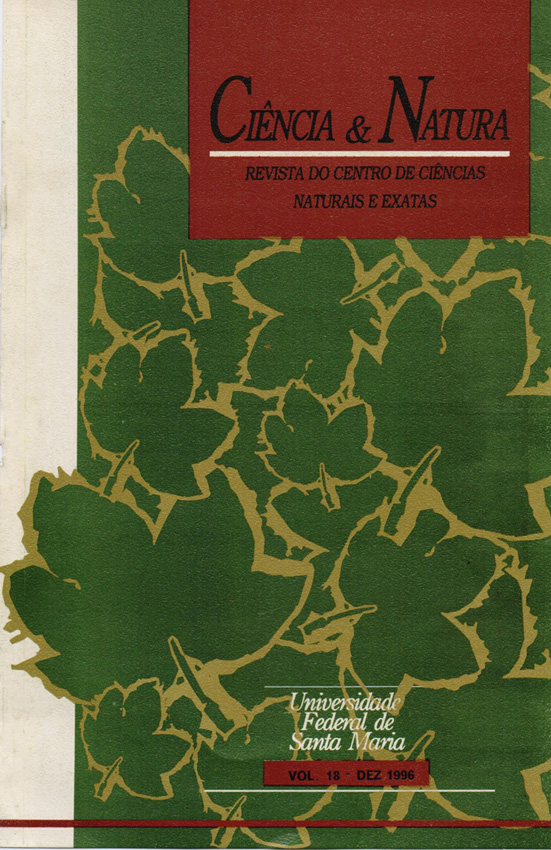Transição metal-isolante em fulleritos dopados com metais alcalinos
DOI:
https://doi.org/10.5902/2179460X26537Resumo
Neste artigo estuda-se a ocorrência dos caráters metálico e isolante em fulleritos dopados com metais alcalinos. Em particular, a ocorrência da fase metálica em sistemas dopados com potássio e a não ocorrência desta fase em sistemas dopados com sódio são analisadas via a aproximação de Gutzwiller em um modelo de Hubbard degenerado. Utilizando parâmetros de interação e larguras de bandas derivadas de cálculos INDO-CI na abordagem de agloramento molecular, em moldes semelhantes aos apresentados anteriormente por Coutinho, Canuto, Mota e Fazzio, as transições metal-isolante são discutidas nesses sistemas. Dos resultados obtidos da relação dos parâmetros de interação e larguras de bandas com a dopagem é possível entender os comportamentos diversos dos sistemas dopados com potássio e sódio com relação ás fases metálicas e isolantes para esses dois sistemas.Downloads
Referências
H. W. Kroto, J. R. Heath, S. C. O'Brien, R. F. Curl e E. Smalley, Nature 318, 162 (1985).
W. Krätschmer, L. O. Lamb, K. Fostiroupolos e R. Huffuman, Nature 347, 354 (1990).
J. H. Weaver, J. Phys. Chem. Solid 53, 1433 (1992).
S. Saito e A. Oshiyana, Phys. Rev. Lett. 66, 2637 (1991); S. C. Erwind e W. E. Pickett, Science 254, 842 (1992); W. E. Pickett, Solid State Phys. 48, 225 (1994).
C. Gu, F. Stepnick, D. M. Poirier, M. B. Tost, P. J. Benning, Y. Chen, T. R. Ohno, José L. Martins, J. H. Weaver, J. Fure e R. E. Smalley, Phys. Rev. B 45, 6348 (1992).
A. F. Hebard, Nature 350, 600 (1991).
S. H. Yang, Chem. Phys. Lett. B 139, 233 (1987).
J. L. Martins e N. Troullier, Phys. Rev. B 46, 1776 (1992).
D. L. Novikov, V. A. Gubanov e A. J. Freeman, Physica C 191, 399 (1992).
H. S. Davidov, Quantum Mechanics, Pergamum Press, Oxford, 559 (1976).
N. W. Ashcroft e N. David Mermin, Solid State Physics, W. B. Saunders Co., Orlando, (1976).
J. Hubbard, Proc. R. Soe. A 276, 238 (1963).
M. C. Gutzwiller, Phys. Rev. Lett. 10, 159 (1963); Phys. Rev. 134, A923 (1964); Phys. Rev. 137, A1726 (1965).
E. A. Guggenheim, Mixtures, p. 38, Oxford University Press, New York, 1952.
R. P. Messner e G. D. Watkins, Phys. Rev. Lett. 25, 656 (1970).
K. Coutinho, S. Canuto, R. Mota e A. Fazzio, Mod. Phys. Lett. B 9, 95 (1995).
C. C. Chen, S. P. Kelty e C. M. Lieber, Science 253, 886 (1991).
J. P. Lu, Phys. Rev. B 49, 5687 (1994).
J. C. Cechin, R. Mota, S. Canuto e A. Fazzio, "Superconductivity and the Electronic Structure ofAxC60" , Workshop on Highly Correlated Systems, LNLS (UNICAMP), dezembro (1994); Thirthy-fifth Sanibel Symposium, University of Florida, USA, março (1995); "Transição Metal-Isolante em Fullerenos Dopados com Metais Alcalinos" , XVIII Encontro Nacional de Física da Matéria Condensada, Caxambu/MG, junho (1995).
S. L. Garavelli e A. Ferraz, Mod. Phys. Lett. B 8, 1223 (1994).
Downloads
Publicado
Como Citar
Edição
Seção
Licença
Para acessar a DECLARAÇÃO DE ORIGINALIDADE E EXCLUSIVIDADE E CESSÃO DE DIREITOS AUTORAIS clique aqui.
Diretrizes Éticas para Publicação de Revistas
A revista Ciência e Natura está empenhada em garantir a ética na publicação e na qualidade dos artigos.
A conformidade com padrões de comportamento ético é, portanto, esperada de todas as partes envolvidas: Autores, Editores e Revisores.
Em particular,
Autores: Os Autores devem apresentar uma discussão objetiva sobre a importância do trabalho de pesquisa, bem como detalhes e referências suficientes para permitir que outros reproduzam as experiências. Declarações fraudulentas ou intencionalmente incorretas constituem comportamento antiético e são inaceitáveis. Artigos de Revisão também devem ser objetivos, abrangentes e relatos precisos do estado da arte. Os Autores devem assegurar que seu trabalho é uma obra totalmente original, e se o trabalho e / ou palavras de outros têm sido utilizadas, isso tem sido devidamente reconhecido. O plágio em todas as suas formas constitui um comportamento publicitário não ético e é inaceitável. Submeter o mesmo manuscrito a mais de um jornal simultaneamente constitui um comportamento publicitário não ético e é inaceitável. Os Autores não devem submeter artigos que descrevam essencialmente a mesma pesquisa a mais de uma revista. O Autor correspondente deve garantir que haja um consenso total de todos os Co-autores na aprovação da versão final do artigo e sua submissão para publicação.
Editores: Os Editores devem avaliar manuscritos exclusivamente com base no seu mérito acadêmico. Um Editor não deve usar informações não publicadas na própria pesquisa do Editor sem o consentimento expresso por escrito do Autor. Os Editores devem tomar medidas de resposta razoável quando tiverem sido apresentadas queixas éticas relativas a um manuscrito submetido ou publicado.
Revisores: Todos os manuscritos recebidos para revisão devem ser tratados como documentos confidenciais. As informações ou ideias privilegiadas obtidas através da análise por pares devem ser mantidas confidenciais e não utilizadas para vantagens pessoais. As revisões devem ser conduzidas objetivamente e as observações devem ser formuladas claramente com argumentos de apoio, de modo que os Autores possam usá-los para melhorar o artigo. Qualquer Revisor selecionado que se sinta desqualificado para rever a pesquisa relatada em um manuscrito ou sabe que sua rápida revisão será impossível deve notificar o Editor e desculpar-se do processo de revisão. Os Revisores não devem considerar manuscritos nos quais tenham conflitos de interesse resultantes de relacionamentos ou conexões competitivas, colaborativas ou outras conexões com qualquer dos autores, empresas ou instituições conectadas aos documentos.






